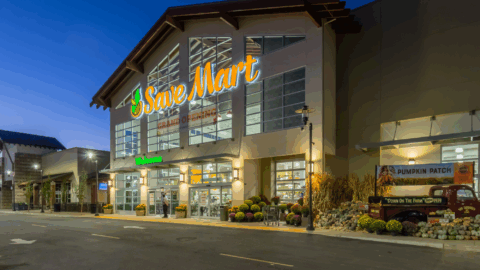It’s hard to turn a profit in ecommerce, and for a long time that didn’t matter. But as ecommerce has become a more prominent contributor to retailers’ bottom lines, and the cost of doing business online gets more expensive (think rising shipping costs and increasing returns), the mere existence of an ecommerce operation is no longer enough — retailers now have to find a way to make money online.

Nicolas Darveau-Garneau has a strong opinion on the topic; in fact, he’s staked his professional life on it. For 11 years he worked at Google, the last three as the tech giant’s Chief Evangelist, where he helped the largest brands in the world hone their digital marketing strategies. He watched businesses of all types pour millions into drawing in customers yet still fail to make a profit, and that was when he realized that marketing strategies weren’t the real problem. The problem, according to Darveau-Garneau, is the experience once consumers arrive at a company’s website. So in January 2022, he joined digital experience solution Coveo as Chief Growth and Strategy Officer to help fix that.
“I’m betting my whole career on retail having to think not just about digital marketing — which they still have to nail, because they’re not there yet — but really focusing on the customer experience,” said Darveau-Garneau in an interview with Retail TouchPoints. “It’s an emergency. This is not a nice to have — the time to do this is right now.”
Darveau-Garneau sat down with Retail TouchPoints to talk about why customer experience and financial viability are intrinsically tied and how ecommerce operators can up their game (and their profit margins).
Retail TouchPoints: Chief Evangelist at Google sounds like such a cool job — why would you leave?
Darveau-Garneau: It was a really fun role, but about two years ago, the conversation started shifting away from digital advertising. Instead, the CEOs and CMOs I was talking to started saying: “I know we need to get more digital, do less TV advertising, so on and so forth, but it’s not my biggest issue. My biggest issue is my customer experience. If I buy a bunch of clicks from Google and Facebook but then send people to a broken experience, that’s not a smart investment. How do I create an Amazon-like customer experience?”
When I saw that switch, I started thinking about leaving Google to be part of the next wave. Digital marketing will be 60%, 70%, 80% of all marketing 10 years from now, and that’s going to continue without me. But executives need a lot of help to create that better experience, and that’s what Coveo does.
Imagine taking an experience that’s subpar and bringing it to Amazon-level within months. That creates a ripple effect that’s really powerful — your marketing now becomes much more profitable, you increase customer lifetime value, people’s likelihood of returning, conversion rate, average order value — everything just goes higher and higher.
When that happens you get into this powerful cycle of increased profitability, which I’m really passionate because I’ve started four ecommerce companies and advised tons of other companies — the dirty secret is nobody’s making money. That was fine when the party was on. Until recently, [the mantra] was growth at all costs — the higher your ecommerce revenues are, the higher your stock goes. But the ecommerce party is over now. Investors are demanding that ecommerce become profitable.
It’s easy to create a higher conversion rate online when you give free shipping for life, 20% off and free massages, but that’s not the goal. The goal is to delight customers, but not give the store away. You can make money — if you delight them, they’ll come back, and that’s always been Amazon’s strategy.
RTP: So how do retailers do that?
Darveau-Garneau: It’s a lot of things, of course. It’s the search engine, it’s all the recommendations, badging. And then it’s about profit optimization, so using machine learning to not just show the right products to each customer, but also the products that are the most profitable. And then lastly, it’s [about helping] merchandisers radically change how they work — from writing thousands of rules to patch a broken system to having a machine do the boring stuff so merchants can start doing much more meaningful things.
Put this all together and this is everything that Amazon does — incredible search, incredible recommendations, profit optimization using machine learning, optimization of a whole lot of the merchandising using machine learning. And then you have a high-value action team that does hundreds of thousands of merchandising tests a year, because machine learning is great, but it doesn’t know what it doesn’t know, and merchants know a lot of things that machines don’t. Combining machine learning and the smarts of merchandisers is the future of ecommerce.
For example, we had a customer that had 14,400 business rules inside of its ecommerce systems — that’s just spaghetti, it gets incomprehensible. They went down to eight rules, and their revenue per visit went up by 12%. Now they actually have 200 to 300 rules, they added more, but those are very different rules than before, things that the machine wouldn’t think of itself.
RTP: Why is profitability so elusive for ecommerce operators?
Darveau-Garneau: Well, shipping costs have gone up, returns have gone up, rebates have gone up because of excess inventory — those are systemic things that have been hard to change. But the fundamental flaw in ecommerce is how products are shown to customers.
If you go into almost any ecommerce site except for Amazon and a few others, you’re going to be shown popular products. Finding chairs, for example, isn’t hard. The hard problem is how to rank the 1,300 results from one to 100. If you’re ranking chairs that are not profitable, you’re not going to make any money. And not only in your ecommerce either — because people pre-shop online, what they see online is also often what they buy in the store.
The vast majority of ecommerce ranking products are based on click through rate (CTR) or add-to-cart rate. That means that almost every single ecommerce site isn’t personalized — they’re showing you the right product for the average customer, and then maybe they put some rules in there around personas.
What’s the problem with that? One, I’m showing the same products to everybody, so the products I’m not showing will never get bought and will have to be discounted. Two, I’m showing the same popular products to everybody, but only 16% of customers want what’s popular — people want what’s right for them, so I’m going to also not delight my customer. Problem three is that not always, but very often, the products people click on a lot or add to cart a lot are discounted.
To solve this, you have to make sure that every single customer sees something different, and that every single product has a chance to be shown. That’s a very difficult problem that Amazon solved. But that’s really, really hard to do, especially because 86% of customers on other ecommerce sites outside of Amazon are not logged in, and that’s going to get worse because of all the privacy issues — so when they show up the retailer knows nothing about them. For that first search, we have to give them the average answer, but what Coveo has figured is out [how to deliver] real-time personalization based on the customer’s behavior on the site.
If you haven’t cracked the problem of personalizing your site when a brand-new customer shows up, it’s really hard to compete against Amazon, so that’s the first thing you have to do. But even that’s not enough, right? You can personalize one to one and delight customers, but still not make money. So the second leg of the stool is the ability to optimize for profitability using machine learning.
Imagine that for every single product, a retailer would input the margins, [answering questions like] how much money am I going to make? How likely is it to get returned? How much excess inventory do I have? What’s the shipping cost? Is the brand advertising this on my site, so if I sell more am I going to make money in advertising?
You add all of these business factors into the mix and rank the products based on two things — what’s relevant for the customer and what’s profitable for us. If you go into a physical store, they put things in the endcaps that make them the most money. Online, you can do it even better because you can change the entire store for every single customer. We’ve been talking about this for 20 years, but now with machine learning, you can do it.
RTP: If machines are doing all the work, where does this leave merchandisers?
Darveau-Garneau: Oh, there’s still plenty for them to do. Right now merchants have to write thousands of rules to do a lot of what I just described. For example, we have a high-margin product that we want to boost — no matter what the algorithm comes up with, we want this item to be No. 1. But imagine not doing that, and instead putting the margin of each product into the machine and then telling the machine “I want to delight customers, but I also want to maximize profits, so automatically boost relevant products that have a high margin.” Now these hundreds of rules to boost high-margin products go by the wayside, you don’t need to write any of them.
So then what do the merchants do? They test things the machine would not have tested on its own. Amazon is heavy into machine learning, but it has a massive team of merchants. Why? Because machines are stupid — they don’t know the questions to ask, they only have answers.
For example, we had a client recently where one of the merchants had a hypothesis — say you have a customer with two pairs of female shoes in their cart. In the recommendations carousel the machine will normally show more women’s shoes. But this merchant said, “Based on my experience, when a woman has got two shoes in her cart, at this point she’s done for herself, and she wants to shop for her child or her husband.” This merchant tested it out, and next thing you know there was a massive lift in profitability. When you see something like that as a merchant, you’re going to get 100 more ideas. So it essentially works as an A-B testing tool for merchants to try out highly complex ideas instead of writing thousands of rules.
RTP: Amazon is clearly the gold standard for all of this, but are there other retailers that are getting it right?
Darveau-Garneau: The born-on-the-web companies are typically way ahead of more traditional retailers, so Wayfair, for example has got a pretty sweet customer experience. In the more traditional realm, Walmart is doing a darn good job, Home Depot as well. The thing is, this is an infinite change management and digital transformation process. Even for our customers, there are always 10 new things they can do that they haven’t yet.
RTP: It sounds like there’s no end point then, no moment when the ultimate customer experience will be achieved?
Darveau-Garneau: No. The systems keep getting better, the machines are learning every day and the merchants have tons of ideas that the machines don’t have. But fundamentally the core principles are universal and timeless. First, one-to-one personalization is a must — it is not okay to be a retailer today and show the same products to everybody, it’s just not going to work. The expectations of customers are so high that if you don’t do this even when the customer is anonymous, I don’t think you survive this recession. Then if you don’t optimize for profit, and you continue to just optimize for popularity, I don’t think you’re going be okay over time either.
And I don’t think I’m exaggerating. Amazon just keeps winning more and more retail market share, and they don’t have to be profitable because they have AWS and their billion-dollar advertising platform. You’re not going to beat them on price; you’re not going to beat them on delivery and convenience — 70% of American households have Amazon Prime. You’re not going to beat them on advertising — they get more advertising than other retailer and they also spend more on advertising. Do a Google search on any product — they just suck all the traffic out of Google.
All of that means that if you do get a customer to your website, you better keep them there. You can match Amazon’s customer experience, and that’s where you can beat them over time.













